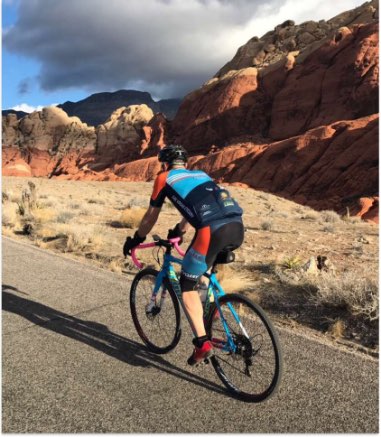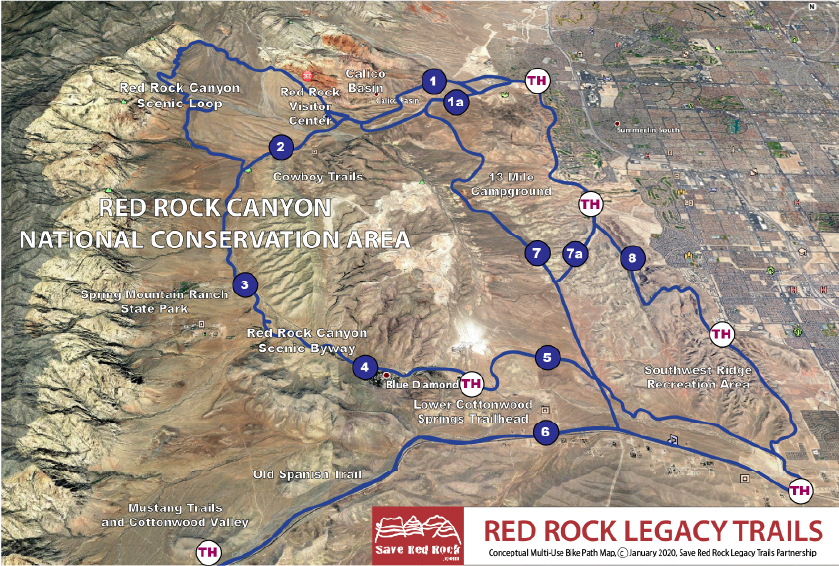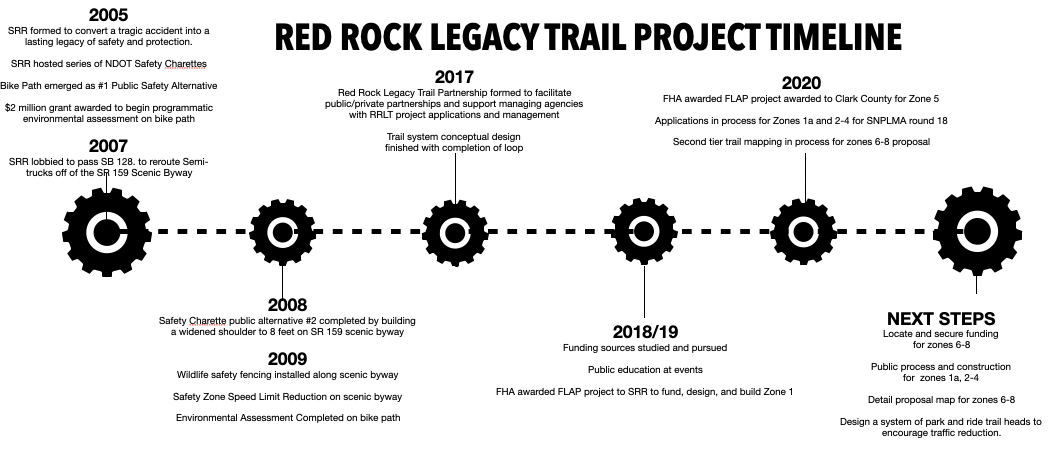The Red Rock Legacy Trail
The latest on SNPLMA round 19 funding for phases 2, 3, 4 can be found at: https://www.blm.gov/programs/lands-and-realty/nevada/snplma
Goals and Significance
Safety + Inclusion
Ensuring that locals and tourists of every skill level, background, or recreational usage (biking, walking, running, etc.) are offered the opportunity to enjoy a free, safe and easy-to-follow trail experience, without the danger of automobile traffic. The trail will make it possible for everyone — especially families with children or pets, those who are differently-abled, older, or from any background or economic threshold — to enjoy the scenery and majesty of Red Rock Canyon National Conservation Area.
Economic Impact
As visitation in national parks soars (both due to COVID-19 and general interest acceleration), and outdoor sports such as biking and running gain in popularity, positioning Red Rock Canyon as a leader among its nearby recreational lands such Zion or Bryce Canyon would offer a greater share of tourism dollars in Las Vegas, in a time when we need it most. The time has never been better for Vegas to diversify and offer safe, outdoor recreation.
Sustainability
Investing in sustainable infrastructure would not only meet current visitation demand for locals and tourists alike, but provide room for visitor growth while protecting the integrity of the sensitive lands surrounding the project. As traffic naturally increases, visitorship is encroaching upon and disrupting this sacred environment. This project would address the issue of unbalanced and concentrated impact by dispersing the recreation, a proven BLM strategy, in a responsible, organized, and channeled manner. And in future phases, we intend to create enticing RRLT Park-and-Ride facilities at the city’s edge to encourage drivers to leave their cars to visit the canyon by biking or running and lessen the impact even further.
Red Rock Legacy Trail Updates
Media Coverage
Red Rock Legacy Trail Overview
During recent Covid restrictions, the Red Rock Scenic Loop was closed to automobile traffic and open only to bikers and hikers on foot from the exit. People with strollers, dogs, kids and bikes were able to enjoy an unprecedented Scenic Drive without traffic. The need for a multi-use paved path has never been more apparent. For all those families, friends and kids happily experiencing the loop without cars, we have exciting news. After 15 long years, we are finally breaking ground on the Red Rock Legacy Trail. We have designed this paved path to meander along the 159 Scenic Byway (not the Scenic Loop) and loop around in front of Blue Diamond Hill and Southwest Ridge. We have planned a two-way biking/running/pedestrian trail similar in design to the River Mountain Loop Trail at Lake Mead. It will meet Las Vegas in the northwest and southwest with state-of-the-art, park-and-ride trailheads to encourage decreased traffic and increased safety and sustainability in the canyon. We are grateful to the federal and local agencies and organizations for working together to address this important public need.

Red Rock Legacy Trails Background
Over the years, Save Red Rock has been successful in improving safety for Red Rock visitors through state and federal legislation and facility improvements, such as lowering the speed limit, stopping urban development, diverting semi truck traffic and adding an 8 foot bike lane to both sides of the SR 159 Scenic Byway.
In response to the public outcry for safety following the tragic accident of cyclist Don Albietz in 2005, Save Red Rock hosted an NDOT public series of Safety Charettes for the Red Rock Scenic Byway. The number one public safety alternative that came out of that series was a separated, multi-use bike/ped path for families and active trail users. Save Red Rock designed the Red Rock Legacy Trail and formed a committee called the Red Rock Legacy Trails Partnership to provide public/private support and advance the community vision to increase safety, reduce traffic and connect Las Vegas communities and visitors to the Canyon with safe, organized, accessible and sustainable recreation opportunities.
The Legacy Behind the Red Rock Legacy Trail
In 2005, local hero, resident metro officer, Iron Man athlete, father, husband, and little league coach, Don Albietz was killed by a hit and run driver while riding his bike on the 159 Red Rock Scenic Byway. His legacy inspired us to create Save Red Rock as an organization to improve safety and the natural experience in Red Rock and to ensure that this kind of tragedy never happens again. The “legacy” trail is also named after the individual and collective legacies of all Save Red Rock’s supporters, including and especially all the people and agencies who are working to make this dream of safety and serenity in the canyon a reality, this legacy a lasting one, for generations to come.
Red Rock Legacy Trails Partnership
The Red Rock Legacy Trails Partnership (RRLTP) is a committee of Save Red Rock designed to facilitate public-private partnerships and collaboration with managing agencies, government entities and stakeholders, to advance and assist planning and support for the Red Rock Legacy Trails project. RRLTP committee meetings include representatives from local, state and federal agencies including:
- Save Red Rock (SRR)
- Nevada Department of Transportation (NDOT)
- Bureau of Land Management (BLM)
- Clark County Board of County Commissioners
- Federal Highway Administration (FHA)
- Federal Lands Access Program (FLAP)
- Regional Transportation Commission (RTC)
- Get Outdoors Nevada (GON)
- Kimley-Horn
- Red Rock Citizens Advisory Council (RRCAC)
- Spring Mountain Ranch State Park (SMRSP)
- International Mountain Biking Association (IMBA)
- Southern Nevada Bicycle Coalition (SNVBC)
- Private Citizens and Stakeholders
Red Rock Legacy Trail Timeline
2005 Growing urban development in Las Vegas and Pahrump resulted in an increased use of the Red Rock Scenic Byway as a commuter/construction route and not just a destination/recreation route. A corresponding increase in injuries and deaths resulted for non-motorist users. In response to this critical condition, we created Save Red Rock (SRR) as an organization to improve safety and the natural experience in the canyon. SRR hosted a series of NDOT Safety Charettes and a separated bike path concept emerged as the public’s #1 safety alternative. SRR initiated a $2 million Environmental Assessment for the separated path with a Federal Grant.
2008 A Programatic Environmental Assessment was completed and submitted to the BLM to study the design and potential route for a paved multi-use path.
2018 Save Red Rock created the Red Rock Legacy Trail Partnership (RRLTP–a public-private partnership with local and federal agencies including NDOT, BLM, Clark County, GON, IMBA, and RTC) to move this project forward. SRR Treasurer and RRLTP Board Member, Sheila B., applied for a Federal Land Access Program (FLAP) project of $9 million to design and construct Phase 1 of the trail from West Tech on West Charleston to the Red Rock Canyon Visitor’s Center. Commissioner Larry Brown, who’s district encompasses Phase 1, agreed to facilitate the required matching funding of $605,000, GON agreed to help with maintenance efforts, and all seven Clark County Commissioners unanimously voted to approve it.
2019 The FLAP project was approved and awarded to SRR for the Central Federal Lands Highway Division to design and construct Phase 1 of the multi-use trail.
2020 In February, Clark County Commission approved matching funding for the northern portion of the trail, Phase 1, from Sky Vista in Summerlin to the Red Rock Canyon Visitor’s Center. In March, Commissioner Justin Jones’ Brandon Munson office worked with Save Red Rock to apply for Phase 5. This portion of the trail in his district, extends from Mountain’s Edge to the town of Blue Diamond. Meanwhile, teams of cultural, biological, and soil scientists conducted field work on the environmental surveys and alignments of Phase 1. Subsequent studies are in process and public meetings are tentatively scheduled for winter 2020 (health circumstances-permitting). In May, Clark County Commissioners unanimously approved the application for Phase 5, and in June, the project was awarded to the County by FLAP. Now both ends of the path can simultaneously move forward.
2021 In August, final project design completed for potential groundbreaking late 2021 for Phase 1. Estimated completion is one year from construction start.
2022 Estimated completion of Phase 1
2025 Construction on Phase 5 from Hualapai/160 to Blue Diamond expected to begin. Estimated completion is one year from groundbreaking.
2026 Estimated completion of Phase 5
Still needed: Funding and support for: phases 2, 3, 4 and 6 to complete the trail system. Save Red Rock is working with local governments and private partnerships to continue this project development and will keep you updated.



















